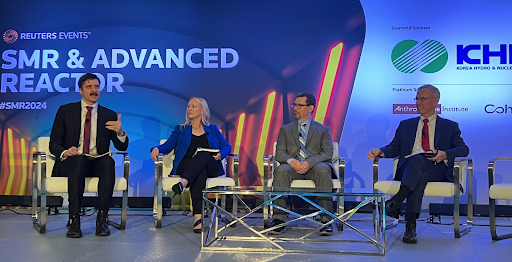
Nelson began the discussion by noting that there have been two recent realizations: 1) People have become aware of the grid and its limitations, and 2) There are many industries and applications that require energy other than electricity. “If you go and try to buy Titanic scales of energy—scales that we’ll hear about in just a moment—what you’re going to find is that you can’t do it. You can’t find giant-scale energy to purchase. You have to develop it,” he said. Nelson discussed the irony that Stein is Director of Nuclear Innovation for an environmental think tank in Berkeley, CA, where nuclear energy is statutorily banned. He asked Stein what changes he had seen since he started at The Breakthrough Institute. “There has been a significant shift in public perception, particularly with younger generations. And the policy has substantially shifted for several reasons: energy security or environmental concerns,” said Stein.
Panelists discussed the scale of energy needs for deep industrial decarbonization. Stein explained, “It is the thermal output of 70 equivalent gigawatt-scale nuclear power plants running for the entire year. Energy is in terms of watts over time, so about 1,700 terawatt hours of heat a year in the US alone.” Nelson asked Bill Labbe about solutions. “Industrial clients are looking for a solution at their location in Canada, their location in the US, and that same product globally,” said Labbe. “They’re looking for a clean solution that can be repeated at their facilities across countries.” Labbe, who started working with pressurized water reactors (PWRs), said he welcomes the simplicity of advanced small modular reactors. “The next-generation reactors are very simple,” said Labbe. “They’re not complicated. They require a reduced staff to maintain and operate. They are exciting in their simplicity and the speed at which we think we can get these to the market.” He added that ARC Clean Technology’s ARC-100 reactor leverages proven technologies developed in the US DOE’s Advanced Reactor Program and that ARC is now working on the construction design.

Nelson asked Henderson what Microsoft’s role is in the energy transition. Henderson noted that Microsoft is:
“I just want to point out that Microsoft considers nuclear energy clean energy,” Nelson reiterated.
Nelson discussed the main barriers to delivering nuclear energy to large consumers like Microsoft. Stein laid out the main challenges of connecting to the grid, deploying energy to the grid, or deploying behind the meter. He also cited the direct investment required and significant regulation hurdles. “It’s a very complex environment right now to meet all these wide-ranging, diverse scenarios,” said Stein.
Labbe cited the benefits of co-locating reactors with industrial facilities. “What’s nice about the sodium fast reactors is the inherent safety,” said Labbe. “Our emergency planning zone turns out to be the site fence. It’s not a 10-mile radius. We can condense it down to a very small footprint.”
The panel noted that customers, including Microsoft, are becoming more sophisticated and knowledgeable about nuclear energy. Henderson summarized that Microsoft has signed a PPA with Helion for fusion technology, issued a policy statement on accelerating a carbon-free future, and announced a partnership with Google and Nucor to aggregate demand to scale the adoption of advanced clean electricity technologies. “Obviously, we are invested in nuclear,” she said.
The discussion turned to the size of the industrial heat market. Stein said, “About 45% of our current manufacturer usage is 300 degrees C or below.” The other 55% of demand requires higher temperatures. Regarding the ARC-100, Labbe explained, “We make sure that we have the highest temperature available out of our steam generator and keep the primary system such that we don’t enter a range where we’re going to challenge our material life. So, we’ve tried to balance that spot.”
Labbe noted that it’s important to have joint engineering discussions to optimize the solution, but moving forward in the regulatory space with customers is even more critical. “What we’re interested in is moving in the regulatory space together, and that can be done in parallel with the other projects that need to be done,” Labbe said.
Stein emphasized that the key to working with the NRC is to have “a standardized roadmap, having cross-developer learning, and attending each other’s meetings to see how things go to significantly streamline the process instead of everyone trying to solve everything on their own.”
The panelists emphasized the need to engage early and often with regulators and to partner with utilities since most industrial and data center users do not want to operate their own nuclear power plants. Said Labbe, “The Generation IV technology is here. In a few more years, we will be ready for deployment. Advanced nuclear is the technology that will decarbonize industry.”
Concluded Henderson, “Our goal is to deliver our data center infrastructure in a way that provides the least environmental impact. And we believe advanced nuclear and fusion technologies help achieve that.”
